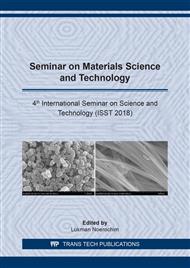p.1
p.7
p.13
p.19
p.26
p.33
p.40
p.45
Investigation of Carbon Composition for Electrochemical Properties as PEMFC Cathode Catalyst
Abstract:
Nitrogen –doped carbon material using non-precious metal was developed as catalyst fuel cell (PEMFC). In the PEMFC, the cathode reaction occurs three times slower than anode reaction. Oxygen reduction reaction (ORR) in the cathode has major limit performance. Pt/C was used as high-cost catalyst materials but many researchers concerned to improve cathode catalyst performance using high-performance and low-cost materials. Nitrogen based active sites on carbon has important role for oxygen reduction reactions process. In this study, compositions of carbon for Fe-N-C were investigated to understand the electrochemical properties and morphological analysis. Urea and PVP as nitrogen (N) source was mixed with graphite (Gt). The ratio of Gt and N were 1:1, 3:1, and 1:3. The mixture was added to FeCl3.6H2O dissolved in ethanol to produce Fe-N/C catalyst. Subsequently powder was introduced to the furnace for the pyrolysis. The catalyst products were analyzed using Potentiostat to show the electrochemical properties of catalyst, X-Ray Diffractometer (XRD) was used to know the compound or phases after catalyst syntheses, Scanning Electron Microscope – Energy Dispersive X-Ray (SEM-EDX) was used to identify the morphology and the chemical compositions of catalyst. As a result, Fe – Gt : N = 1:3 catalyst had the greatest electrochemical properties which is identified by large area of CV curve. This catalyst also had the highest current density for reduction reaction. The presence of Fe2O3 and FeS caused the degreasing of catalytic activity. As conclusions of this research, carbon composition had the important rule to improve the ORR activity.
Info:
Periodical:
Pages:
13-18
Citation:
Online since:
July 2019
Keywords:
Price:
Сopyright:
© 2019 Trans Tech Publications Ltd. All Rights Reserved
Share:
Citation:


